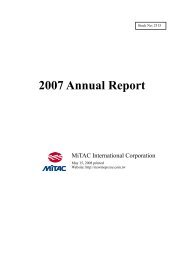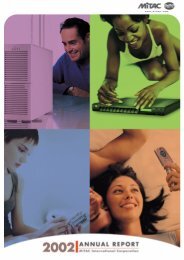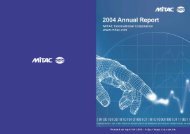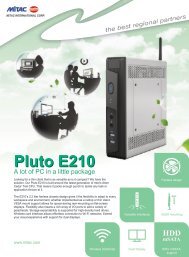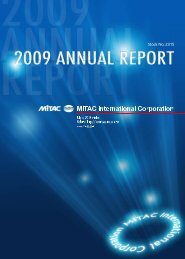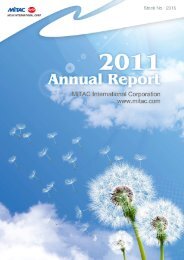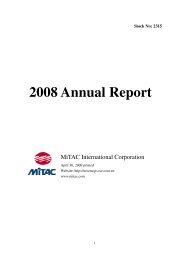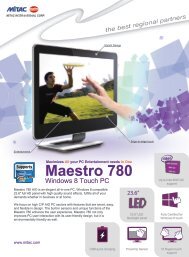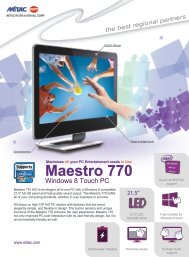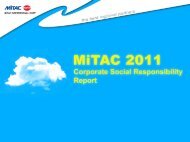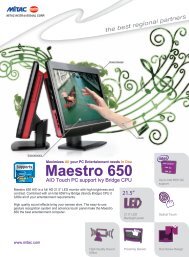Contents - MiTAC
Contents - MiTAC
Contents - MiTAC
You also want an ePaper? Increase the reach of your titles
YUMPU automatically turns print PDFs into web optimized ePapers that Google loves.
eceivable, notes receivable and other receivables.<br />
7) Inventories<br />
A. Inventories of the Company are stated at standard cost, which is adjusted to<br />
actual cost based on the weighted average method at year end. Inventories of the<br />
consoliated subsidiaries are stated at cost using the weighted average method or<br />
the average method.<br />
B. Inventories of the Company and subsidiary companies are valued at the lower of<br />
cost or market value at balance sheet date.<br />
8) Long-term investments<br />
A. Long-term investments in which the Company or its consolidated subsidiaries<br />
owns less than 20% of the investee company’s voting rights and has no<br />
significant influence on operational decisions of the investee company are<br />
accounted for at the lower of cost or market value for listed companies and at<br />
cost for unlisted companies. The unrealized loss resulting from the decline in<br />
market value of the investment, accounted for under the lower of cost or market<br />
value method, is deducted from stockholders' equity. When it becomes<br />
evidently clear that there has been a permanent impairment in value and the<br />
chance of recovery is minimal, loss is recognized in the current years’ income.<br />
For investments accounted for under the equity methods, the difference between<br />
the Company’s cost and underlying equity in the net assets of the investee<br />
company at the date of investment is amortized over 5~10 years.<br />
B. For investments accounted for under the equity methods, the Company<br />
recognizes investment gains or losses by quarter. The unrealized profits and<br />
losses from intercompany transactions between the Company and investee<br />
company during the current year shall be eliminated.<br />
C. Long-term investments in both listed and unlisted companies in which the<br />
Company and / or its consolidated subsidiaries own at least 20% of the investee<br />
company’s voting rights are accounted for under the equity method, unless the<br />
Company is unable to exercise significant influence over the investee.<br />
D. The exchange difference arising from the translation of long-term investments<br />
denominated in foreign currencies is included in the Company's stockholders'<br />
equity account as "Cumulative Translation Adjustment".<br />
9) Property, plant and equipment<br />
A. Property, plant and equipment are stated at cost. Interest incurred on loans<br />
used to finance the construction of property and plant is capitalized and<br />
depreciated accordingly.<br />
B. Depreciation is calculated on a straight-line basis over the assets estimated<br />
useful lives. Residual values of fixed assets still in use at the end of the<br />
original service lives are depreciated based on the newly estimated remaining<br />
service lives of the assets. The useful lives of the fixed assets are 2 – 10 years,<br />
except for buildings, which are 3 - 55 years.<br />
C. Maintenance and repairs are charged to expense as incurred. Significant<br />
renewals and improvements are treated as capital expenditure and depreciated<br />
accordingly.<br />
D. Idle assets are valued at the lower of book value or net realizable value (based<br />
on the appraised value of real estate appraisal company) and classified as other<br />
assets. Rental assets are valued at cost and classified as other assets; current<br />
depreciation is recorded as non-operating expense.<br />
10) Intangible assets<br />
Land usage rights are amortized on a straight-line method over 48~50 years.<br />
- 53 -



